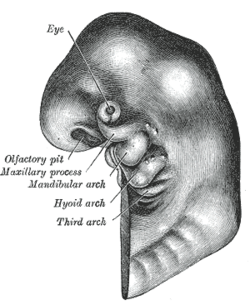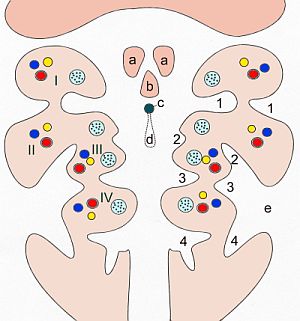Pharyngeal arch
| Branchial arch | |
|---|---|
 Schematic of developing fetus with first, second and third arches labeled. | |
 Floor of pharynx of human embryo about twenty-six days old. | |
| Details | |
| Carnegie stage | 10 |
| Identifiers | |
| MeSH | D001934 |
| TE | arch_by_E5.4.2.0.0.0.2 E5.4.2.0.0.0.2 |
| Anatomical terminology | |
In the development of vertebrate animals, the pharyngeal arches (also called branchial arches or gill arches in fish) are anlage for a multitude of structures. In humans, they develop during the twelfth week in utero as a series of mesodermal outpouchings on the left and right sides of the developing pharynx. In fish, the branchial arches give rise to gills.
Development
These grow and join in the ventral midline. The first arch, as the first to form, separates the mouth pit or stomodeum from the pericardium. By differential growth the neck elongates and new arches form, so the pharynx has six arches ultimately.
Each pharyngeal arch has a cartilaginous stick, a muscle component which differentiates from the cartilaginous tissue, an artery, and a cranial nerve. Each of these is surrounded by Mesenchyme. Arches do not develop simultaneously, but instead possess a "staggered" development.
Relations
Pharyngeal or branchial pouches form on the endodermal side between the arches, and pharyngeal grooves (or clefts) form from the lateral ectodermal surface of the neck region to separate the arches. [1]
The pouches line up with the clefts, and these thin segments become gills in fish.
In mammals the endoderm and ectoderm not only remain intact, but continue to be separated by a mesoderm layer.
Specific arches
There are six pharyngeal arches, but in humans the fifth arch only exists transiently during embryologic growth and development. Since no human structures result from the fifth arch, the arches in humans are I, II, III, IV, and VI. [2]
More is known about the fate of the first arch than the remaining four. The first three contribute to structures above the larynx, while the last two contribute to the larynx and trachea.
Use in staging
The development of the pharyngeal arches provide a useful morphological landmark with which to establish the precise stage of embryonic development. Their formation and development corresponds to Carnegie stages 10 to 16 in mammals, and Hamburger-Hamilton stages 14 to 28 in the chicken.
See also

a Tuberculum laterale
b Tuberculum impar
c Foramen cecum
d Ductus thyreoglossus
e Sinus cervicalis
References
- ^ "Lecture 24. Branchial Apparatus". Retrieved 2007-09-09.
- ^ "Text for Pharyngeal Arch Development". Retrieved 2007-09-09.
- ^ "marshall.edu". Retrieved 2007-09-09.
- ^ a b Netter, Frank H.; Cochard, Larry R. (2002). Netter's Atlas of human embryology. Teterboro, N.J: Icon Learning Systems. p. 227. ISBN 0-914168-99-1.
{{cite book}}: CS1 maint: multiple names: authors list (link) - ^ a b Kyung Won, PhD. Chung (2005). Gross Anatomy (Board Review). Hagerstown, MD: Lippincott Williams & Wilkins. ISBN 0-7817-5309-0.
External links
- Graham A, Okabe M, Quinlan R (2005). "The role of the endoderm in the development and evolution of the pharyngeal arches". J. Anat. 207 (5): 479–87. doi:10.1111/j.1469-7580.2005.00472.x. PMID 16313389.
{{cite journal}}: CS1 maint: multiple names: authors list (link)
